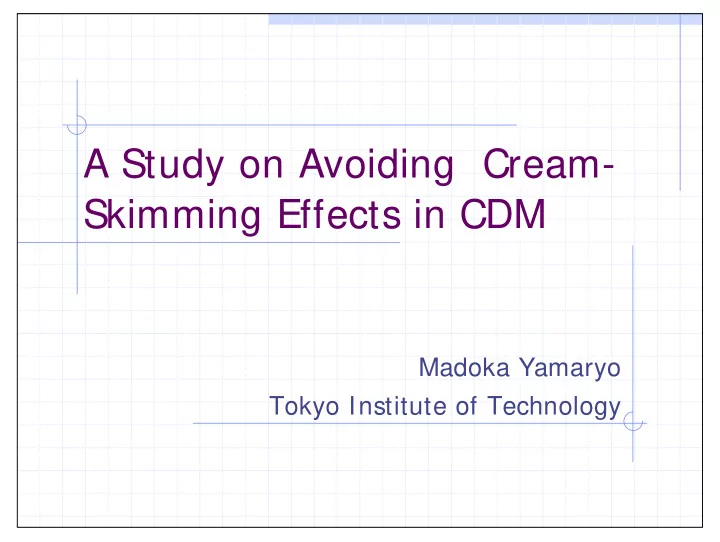

A Study on Avoiding Cream- Skimming Effects in CDM Madoka Yamaryo Tokyo Institute of Technology
Cream-Skimming Effect in CDM Annex I countries implement only low cost CDM projects. Implemented projects do not contribute to the sustainable development of developing countries.
Abatement Costs of 400 total cost of AIJ Projects the project Implemented in 350 cost as AIJ Developing Countries (US$/t-CO2) project 300 renewable energy 250 energy efficiency abatement cost 200 agriculture & fugitive gas capture 150 forest 100 50 0 AIJ Project Report project type UNFCCC(2000)
Past Analysis and Problems Quantitative Analysis on CDM ・ Use the same framework as emissions trading. ・ Projects of lowest marginal abatement costs are being implemented first. Participation of Private Companies ・ Active participation is expected ・ Private companies prefer projects of low abatement cost.
Aims of This Study Argue on the importance of implementing CDM projects of high cost Find incentives for Japanese private companies to invest in high cost CDM projects
Settings of the Model Analysis regions Japan, China, rest of the world 1995 - 2020 ( recursive ) time period of the analysis database GTAP investing country Japan host country China affforestation, energy saving projects CDM projects considered in the iron and steel sector 2001 - 2010 investing period Japan 2001 starting year of GHG abatement China & row 2016 GHG considered CO2 emitted from fossil fuels
CO 2 Emission Constraints China & rest of Period Japan the world abatement starts from 2001- 2001, emissions are none 2010 reduced to 94% of the 1990 emission in 2010 none until 2015, emissions are gradually 2011- fixed to the 2015 reduced to 94% of the 2020 emission from 2010 emission in 2020 2016
Treatment of CDM Projects in the Model emissions right iron & steel sector CO 2 CO 2 CO 2 CDM Project emissions CO 2 constraint Production iron & steel Consumption conventional sector with forest iron & steel CDM sector sector equipments fossil fuels electricity investment Chinese domestic CDM capital capital CHINA JAPAN
Scenarios in the Analysis explanation of scenarios investment in Scenario CDM Project affforestation by China (from 2015) × × no constraint × ○ domestic scenarios ○ ○ energy saving 1 with CO2 emissions ○ ○ energy saving 2 constraints ○ × afforestation
Abatement Costs of Projects Abatement Cost Scenario Reference (US$/t-CO2) coke dry quenching Energy saving 1 30 facility energy conservation in Energy saving 2 37.5 electric furnace used for ferro-alloy refining Afforestation 5.2 afforestation
Scale of CDM Projects two cases: Japan receives the emissions right of ・ 1 % ・ 5 % of the 1990 Japanese CO2 emission in 2010 2500 1% 5% 2000 1500 1000 500 investment in 2010 0 (in 1995 million US$) energy saving energy saving afforestation 1 2
Result for Japan 50% 1% 45% 40% 35% GDP recovery 1% 30% considering CDM 25% investment 20% 5% 15% 10% 5% 5% considering 0% CDM investment energy saving 1 energy saving 2 afforestation Recovery of GDP in 2010 comparing to the “ domestic ” scenario
Result for China - 1 index: average increase of CO2 emission / average GDP growth between 1995 and 2010 scenario no energy energy domestic afforestation CDM constraint saving 1 saving 2 investment none 0.648 0.651 - - - 1% - - 0.651 0.650 0.651 5% - - 0.649 0.649 0.650
Result for China - 2 energy energy domestic saving 1 saving 2 afforestation -195.00 1% -200.00 5% -205.00 -210.00 -215.00 -220.00 -225.00 Difference of GDP between scenarios with CO2 abatement and “ no constraint ” scenario in 2020 (1995 trillion US$)
Aim of the Questionnaire – What are the incentives for the companies to invest in high cost CDM projects? What are the incentives that mainly relate to costs? ex.) the cost of the project itself becomes cheaper the cost of the project is cheaper than other ways of reducing GHGs the cost of the project is cheap in the long run What are the incentives that do not mainly relate to costs? ex.) able to save time of procedures rules of CDM force companies to invest in high cost projects conventional investment activities are admitted as CDM projects obtain more business opportunities in developing countries
Companies visited Number of Sector companies visited Electric power 2 distributing Iron and steel 2 manufacturing Paper manufacturing 1 Trading 2
Results of the Questionnaire “ To find advantages other than reducing GHGs in high cost CDM projects so that other bodies bear a part of the cost ” was supported by all the companies that have answered the questionnaire. Companies regard costs as very important. Incentives that do not mainly relate to costs: Could not find strong incentives.
Conclusion - 1 For Japan, it is better to invest in low cost CDM projects such as afforestation. However, Japan still obtains benefits by investing in relatively high cost CDM projects such as energy efficiency projects. China benefits more from high cost CDM projects not only economically but also in terms of environment and future actions taken by itself against global warming.
Conclusion - 2 Companies regard costs of CDM projects as very important. In order for Japanese private companies to invest in high cost CDM projects, it is effective to find advantages other than reducing greenhouse gases so that other bodies bear a part of the cost.
Recommend
More recommend